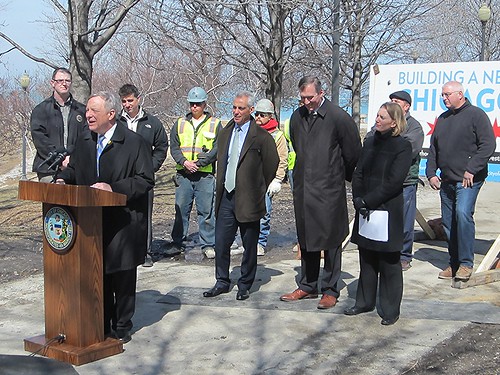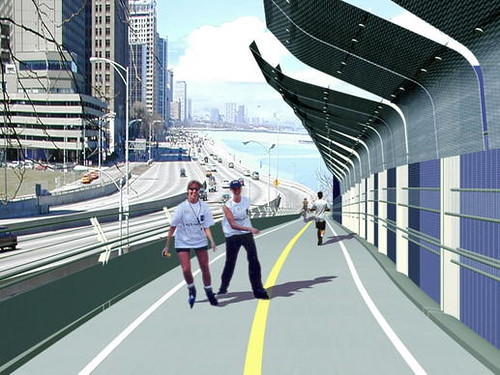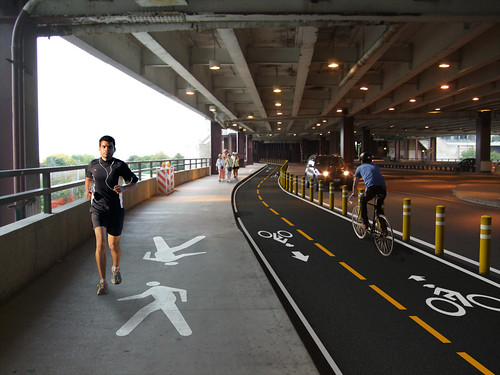After more than a decade of planning, the Chicago Department of Transportation finally kicked off work on the Navy Pier Flyover, a $60 million project that will solve the problem of the dangerous bottleneck at the center of the 18.5-mile Lakefront Trail. “We at the city have discussed this, we have debated it, we have deferred it for decades, and now it’s time to build it,” said Mayor Rahm Emanuel at a groundbreaking this afternoon.
The 16-foot-wide flyover will take pedestrians and bicyclists from south of the Chicago River, up to the level of Lake Shore Drive and around Lake Point Tower, then back down to Jane Addams Park. It will provide much more elbow room for trail users, as well as grade separation from the hazardous Illinois and Grand intersections. The most expensive single bike project in Illinois history, it will cost more than twice the pricetag of the $27.5 million, 3,000-vehicle Divvy bike-share system.
Back in 2012, when the flyover was estimated to cost only $45 million, Streetsblog’s Steven Vance proposed a much cheaper alternative solution, which would have involved converting a lane of Lower Lake Shore Drive into a two-way protected bike lane. He estimates the cost at $3-5 million, including metal bollards, street markings, signal improvements and other upgrades.
At the groundbreaking, I asked new CDOT Commissioner Rebekah Scheinfeld if she was familiar with Steven’s proposal. She wasn’t, but argued that the $60 million expense, which will largely be paid for via federal dollars, is justified. The first phase of construction, between Addams Park and the Ogden Slip, will cost about $26 million, funded by $18 million in Congestion Mitigation and Air Quality Improvement money and other federal funds, plus $8 million from the Illinois Department of Transportation.
“Millions of people use this section of the lakefront and the whole lakefront trail every year,” Scheinfeld told me. “It’s really important to continue to invest in the safety and the quality of the lakefront trail, which is a jewel of Chicago… This is everyman’s park, and this is where everyone should be able to come and recreate safety and enjoy what the lakefront has to offer, whether they’re walking or biking.”
Setting aside the question of whether this was the most cost-effective solution to the central trail’s safety problem, it’s certainly a great thing for Chicago cycling that the issue is being addressed. U.S. Senator Dick Durbin said as much at the press event. “I’ve tried to ride my bike down this trail, and when you reach this point it is some combination of bumper cars, whack-a-mole, I can’t even describe it to you, but you take your life into your hands trying to move from this spot to the other side,” he said. “I’m looking forward to the completion, and the safe navigation of my bicycle through this path.”

It also speaks well of the city’s commitment to improving cycling that the flyover will consist of Cadillac-level infrastructure. At its zenith, it will provide breathtaking views of the lakefront and skyline, which will be a nice change from the dungeon-like atmosphere one currently endures when traveling beneath the drive.
Construction on the first phase will start next week and is scheduled to be finished by December 2015. This will involve the temporary closure of the right travel lane and shoulder of northbound Upper Lake Shore Drive for one block between Illinois and Grand. The off-ramp from the upper drive to Illinois will also be reduced to one lane. The traffic impacts are expected to last into this September.
The second phase covers the area between the slip and the river, and the final phase involves improving the path over the river bridge. The entire project is slated for completion by 2018. CDOT promises that the trail will remain open to pedestrians and cyclists throughout the entire project, with the path detouring around construction.





